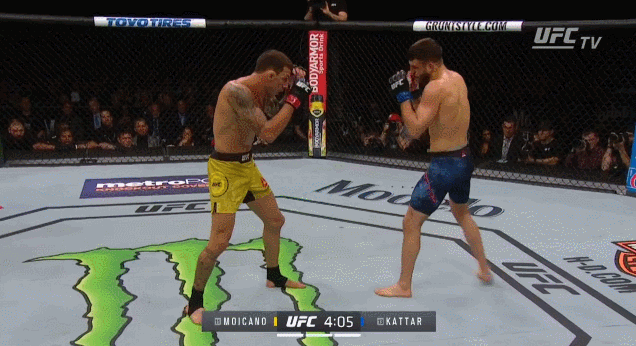
How can you adapt your skills in boxing for MMA? With the popularity of Mixed Martial Arts continuing to grow, we’re seeing more athletes from a boxing background step into the cage. While the rulesets may be vastly different between Boxing and MMA, there are a few adjustments that can be made to your boxing game to make it work in MMA. Let’s discuss 3 strategies that can make boxing for MMA successful.
Wrestling (or the reverse of it)
Let’s address the elephant in the room. While it’s not a boxing technique, a little wrestling knowledge is vital to make your boxing for MMA work. If you want to let your hands go, you’ll need to know how to stay on your feet. We’re not suggesting you become an Olympic level wrestler overnight. We are suggesting however that you learn how to get back to your feet if you get taken down.
Mixed Martial Arts is a dynamic sport with many different positions on the ground as well as standing up. Understanding how to get from a grounded position to a standing position will help make your boxing work in MMA. It will also be valuable to learn basic wrestling defense. This is beneficial for two reasons. Not only will you learn to resist your opponents wrestling attempts with the correct techniques. You’ll also be wearing down their cardio, eventually creating opportunities for you to lands strikes later down the track.

Chuck Liddell is a UFC legend that birthed the ‘Sprawl and Brawl’ style. This style is characterised by using defensive wrestling techniques, or ‘reverse wrestling’ to keep the fight standing and land his heavy hands. Chuck is a Division 1 wrestler with deep knowledge of the sport of wrestling, but he only needed a few key defensive wrestling techniques to make his boxing for MMA successful.
Check out this analysis by Sonny Brown for a further breakdown of Chuck Liddell’s Sprawl and Brawl style:
Range
Now that we’ve discussed wrestling (mainly defense), let’s talk about positioning. Every MMA fight starts on the feet. For a boxer, it’s in your best interest to keep it that way. To ensure you avoid being taken down, you’ll have to fight your opponent from a range where you can successfully detect takedown attempts while keeping your opponent within reach of your punches. Under these parameters it makes sense to step in with your jabs. Step in Jabs from long range minimise the risk of getting caught out of position while allowing your feet to move freely should you decide to change your range or angle.

UFC Featherweight Calvin Katter successfully used this strategy of stepping in on his jabs to put away the high level wrestler Ricardo Lamas.
Initiating your attacks from long range will allow you to keep your hips away from a wrestle happy opponent until you’re ready to close the distance. It’s also important to prioritise your straight punches until the threat of your opponents takedown attempts have been diminished by their fatigue. Being light on your feet and always in a position to ‘Stick and Move’ will be your best bet if you want to make your boxing for MMA style work.
For a more in depth breakdown of Katter’s boxing heavy MMA style, check out Martial Lim’s analysis on Youtube.
Leg Kicks (check them!)
Ahh leg kicks, the bane of a boxer’s existence. Boxing is an effective system of combat. But there is no denying that the threats from the waist down are pretty much non existent. Kicking is illegal in Boxing, and legal in MMA, so it’s probably time you learnt to deal with them. Especially the leg kick. We all understand that movement is a big part of making boxing work for MMA (as mentioned above). With this in mind, the preservation of your thighs and calves should be a top priority when entering the cage. While Calvin Katter’s boxing for MMA shines against wrestling based fighters, he’s prone to getting leg kicked by fighters with a strong Muay Thai background. As we can see in the gif below, Renato Moicano times Katter’s jab beautifully to slip inside and land a heavy leg kick.

So how do we deal with leg kicks? There are two strategies we can employ to minimise our opponents use of the leg kick. The first is probably pretty obvious, Check the kicks. A ‘Check’ is a defensive Muay Thai technique where you block kicks using your shins. It’s true, it’s painful to block with your shin. But it’s also painful for your opponent to connect their shin with yours at full force. Trust us, they’d much rather connect with your thigh or calf (just ask Conor McGregor).
The second strategy is the use of feints. Timing is key for landing leg kicks. If you can successfully use jab feints to disrupt your opponents timing of the leg kick you’ll increase your chances of landing the jabs that you commit to. Missing a leg kick can also leave your opponent out of position which will present you with an opportunity to land a counter strike of your own.
Click here to learn more about the different styles of Kick Boxing and its techniques.
Final Thoughts
Mixed Martial Arts is a dynamic sport with many opportunities to innovate. Boxing provides a great base to start from in MMA with its emphasis on movement and angles. Understanding the rules and strategies to make boxing for MMA successful can be a rewarding journey. It will no doubt also enrich your experience in combat sports and help you appreciate other styles.


